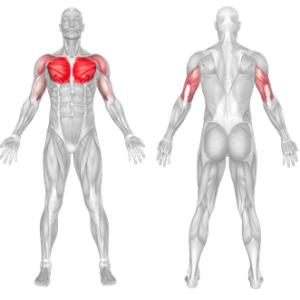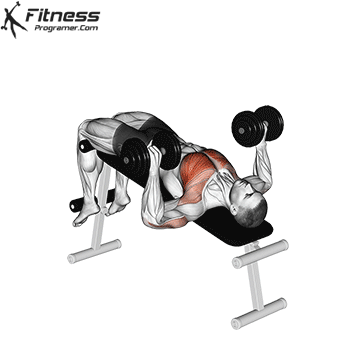Decline Dumbbell Press Overview
The Decline Dumbbell Press is a chest exercise that targets the lower portion of the pectoralis major. It is performed using dumbbells while lying on a decline bench, angled downward (typically 15-30 degrees). Combining this exercise with other chest variations will help you achieve a well-rounded chest development.
How to Perform the Decline Dumbbell Press
Setup
- Set a decline bench at a 15–30 degree angle.
- Grab a pair of dumbbells and sit on the bench with your feet secured under the support pads.
- Lie back with the dumbbells held at shoulder level, palms facing forward, and elbows bent at about a 90-degree angle.
Execution
- Press Upward: Exhale as you press the dumbbells upward in a smooth, controlled motion until your arms are fully extended (but not locked).
- Lower Slowly: Inhale as you lower the dumbbells back to the starting position, maintaining control and ensuring the elbows stay slightly below chest level for a deep stretch.
- Repeat for the desired number of repetitions.
Coach Tips
- Focus on Form: Prioritize proper form over heavy weights to maximize effectiveness and safety.
- Squeeze at the Top: Contract your chest muscles at the peak of the movement for optimal engagement.
- Controlled Tempo: Use a slow and controlled tempo to maintain tension on the chest muscles.
- Pair with Incline and Flat Presses: Combine with other bench press variations for complete chest development.
Common Mistakes
- Flared Elbows: Keep elbows at a 45-degree angle to reduce shoulder strain.
- Excessive Weight: Using too much weight can compromise form and increase injury risk.
- Rushed Reps: Perform the movement slowly to maximize control and engagement.
- Incorrect Bench Angle: Ensure the decline angle is not too steep, as this can reduce chest activation and place undue strain on the shoulders
Benefits Of Decline Dumbbell Press
1. Lower Chest Development
- The Decline Dumbbell Press places a greater emphasis on the sternal head of the pectoralis major, which is the lower portion of the chest.
- By targeting this area, the exercise helps in creating a balanced and well-developed chest. This leads to a fuller, more sculpted look, especially when combined with other chest exercises like the flat and incline presses.
- It’s ideal for individuals looking to achieve that classic chiseled look in the lower chest region.
2. Improved Range of Motion
- Unlike barbell presses, dumbbells allow for a much greater range of motion. You can achieve a deeper stretch at the bottom of the movement and a more complete contraction at the top.
- This increased range helps activate more muscle fibers in the chest, contributing to better muscle growth and enhanced chest definition.
3. Symmetry and Balance
- The independent movement of each arm during the decline dumbbell press helps to address any existing muscle imbalances.
- Each side works separately, ensuring both the left and right pectorals develop evenly and symmetrically, reducing the likelihood of strength or size discrepancies.
- This also helps improve overall body balance and reduces the risk of compensatory movements caused by muscle dominance.
Muscles worked



